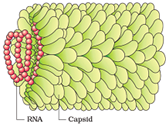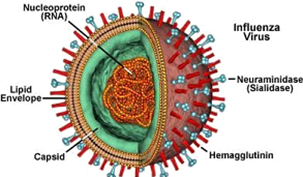Science > Biology > Classification of Microbes, Protists, and Fungi > Viruses
In the five-kingdom classification of Whittaker, there is no mention of some acellular organisms like viruses and viroids and lichens. Viruses did not find a place in classification since they are not truly ‘living’ if we understand living as those organisms that have a cell structure. They are non-cellular organisms that are characterized by having an inert crystalline structure outside the living cell.
Once they infect a cell they take over the machinery of the host cell to replicate themselves, killing the host. The name virus that means venom or poisonous fluid was given by Pasteur.
Evidence that Show Viruses are Living:
- They have genetic material (RNA or DNA)
- They can grow
- They can be transmitted from one host to another.
- They are capable of multiplication in the host.
- They can mutate.
- They show irritability because they react to heat, radiation, and chemicals.
Evidence that Show Viruses are Non-Living:
- They can be crystallized and stored for a very long time.
- They don’t have a cell wall or cytoplasm.
- They are inert outside the host.
- They don’t have cell organelles or don’t have a metabolism.
- They can not function outside the host.
- They do not show cell division.
Structure of Viruses:
They were found to be smaller than bacteria because they passed through bacteria-proof filters. W.M. Stanley (1935) showed that viruses could be crystallized and crystals consist largely of proteins. In addition to proteins, viruses also contain genetic material, that could be either RNA or DNA. No virus contains both RNA and DNA. A virus is a nucleoprotein and the genetic material is infectious.
In general, viruses that infect plants have single-stranded RNA and viruses that infect animals have either single or double-stranded RNA or double-stranded DNA. Bacterial viruses or bacteriophages (viruses that infect the bacteria) are usually double-stranded DNA viruses.
The protein coat called capsid made of small subunits called capsomeres protects the nucleic acid. These capsomeres are arranged in helical or polyhedral geometric forms.
Types of Viruses:
Plant Viruses:

- The viruses which infect and attack plants are called plant viruses.
- They have single-stranded RNA either ss-RNA or ds-RNA.
- They show helical symmetry
- They are mostly rod-shaped or cylindrical.
Animal Viruses:

- The viruses which infect and attack animals are called animal viruses.
- They have either single or double-stranded RNA or double-stranded DNA.
- They show radial symmetry.
- They are mostly rod polyhedral in shape.
Bacterial Viruses:

- They are also called Bacteriophages.
- The viruses which infect and attack bacteria are called bacterial viruses.
- They have a DNA strand.
- They show radial symmetry
- They are mostly tadpole in shape.
Economic Importance of Viruses:
Plant Diseases:
Little leaf of brinjal:

The characteristic symptom of the disease is the marked reduction in the size of the leaves. The newly formed leaves become progressively smaller. The petioles are very much shortened. The leaves appear appressed to the stem and become narrow, soft, glabrous, and yellow. The internodes are shortened. The axillary buds are stimulated to sprout, and they grow into short branches with very small leaves. In severe cases, affected plants do not bear any fruit, or, if formed, it becomes hard and tough.
Yellow vein mosaic of lady’s finger(Bhendi or okra):

Yellow vein mosaic was first reported in okra plants in 1924 in India and Sri Lanka. The symptoms include alternate green and yellow patches, vein clearing, and vein chlorosis of leaves. The yellow network of veins is very conspicuous, and vein and veinlets are thickened. In severe cases, the chlorosis may extend to the interveinal area and may result in complete yellowing of leaves. Fruits are dwarfed, malformed, and yellow-green.
Potato Leaf Roll:

The potato leaf roll virus causes a very well visible leaf rolling up. the leaflets are curled up to form a small boat. Infected plants are dwarf, the leaves are very fragile, and the whole plant is light.
Papaya leaf curl:

It was first reported in Tamil Nadu in 1939. The most prominent symptoms are the rolling of the leaves downward and inward in the form of an inverted cup and the thickening of veins. Sometimes all the leaves at the top of the plant are affected by these symptoms. In advanced stages of the disease, defoliation takes place and the growth of the plant is arrested.
Bunchy top of banana:

The leaves remain bunched up, with yellow fringes and stand erect. The bunchy top symptom is usually most visible on young plants. Bunchy top symptom can be more subtle on older banana plants. The production of banana fruit becomes uneconomical and unprofitable.
Grassy shoot of sugarcane:

This disease is characterized by the production of numerous small and thin tillers having narrow leaves. Diseased plants exhibit varying degrees of loss of chlorophyll, ranging from total green to white. Premature & excessive tillering gives a crowded appearance like ‘grass’ to the clump. The root system of the affected plant reduced and plants are usually reduced in height (stunted growth). Affected clumps hardly produce one or two weak canes.
Tobacco Mosaic Disease:

Symptoms induced by Tobacco mosaic virus (TMV) are somewhat dependent on the host plant and can include mosaic, mottling, necrosis, stunting, leaf curling, and yellowing of plant tissues. The symptoms are very dependent on the age of the infected plant, the environmental conditions, the virus strain, and the genetic background of the host plant.
Animal Diseases:

Viroids:
In 1971, T. O. Diener discovered a new infectious agent that was smaller than viruses and caused potato spindle tuber disease. It was found to be a free RNA; it lacked the protein coat that is found in viruses, hence the name viroid. The RNA of the viroid was of low molecular weight. These are mainly plant pathogens. The viroids do not show dormant state. The diseases caused by viroids are Citrus exocortis Chysanthemum stunt Cucumber bale fruit Potato spindle tuber.
2 replies on “Viruses”
I’ve learn about virus clear.and the explanations are long.my doubt is clear now.
Bahut hi sunder